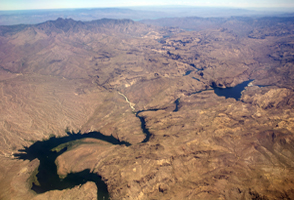August 25, 2015

In the grips of long-term drought, the Colorado River Basin and the cities that rely on its water face unprecedented challenges and significant uncertainty with a warming climate and large-scale land-use change. They are developing new water-resource policies for a future of increasing uncertainty.
Now, water managers and decision makers of cities of the Colorado River Basin will be able to take greater advantage of Arizona State University’s Decision Center for a Desert City (DCDC) thanks to a new $4.5 million National Science Foundation award.
The four-year award, the third made to DCDC in its 10-year history, brings the total NSF investment in the center to $18 million. It will allow ASU to expand the geographic scope of DCDC’s work beyond Phoenix to include cities dependent upon Colorado River water in states like Colorado, Nevada and California to explore transformational changes that will be necessary to sustain water supplies well into the future.
Decision Center for a Desert City, which is a research unit of the Julie Ann Wrigley Global Institute of Sustainability at ASU, conducts climate, water and decision research, and it develops innovative tools to bridge the boundary between scientists and decision makers.
DCDC researchers work closely with the Decision Theater Network to engage stakeholders using models and simulations that visualize alternative futures and to promote dialogue about sustainability solutions.
“It is an unprecedented time to conduct this type of use-inspired research for the Colorado River Basin region,” said Dave White, director of Decision Center for a Desert City. “It comes with a greater sense of urgency and a greater sense of understanding of the scale and scope of the changes that are likely necessary to transition the cities and the region into a more sustainable state over the next several decades.”
The work of the center's researchers is interdisciplinary, integrated across areas such as hydrology, water science, economics, anthropology, geography, policy and sustainability, White explained. A primary tool developed by DCDC is WaterSim 5.0, a “systems dynamics model” that can help drought-ravaged cities anticipate a range of possible future conditions and build capacity for sustainable water-resource management and climate adaptation. David Sampson, a research scientist with the center, developed the model.
WaterSim’s power lies in its ability to bring together the multifaceted issues faced by water users and suppliers and play out scenarios so to provide a clearer picture of what the future might hold. Until now WaterSim had integrated the needs and policies of the 33 cities that make up the Phoenix metropolitan area.
“At the center of everything is the question, ‘How do we make better decisions about the future and managing our resources in a sustainable way?’” said White, an associate professor in the School of Community Resources and Development in ASU’s College of Public Service and Community Solutions. To do that the center will conduct research across four integrated project areas.
One integrated project area will focus on the biophysical process models that simulate climate change, urbanization, land use and hydrological processes in the Colorado River Basin to produce a set of climate and land-use scenarios. The second integrated project area will focus on models of the social, economic and institutional considerations of the region, the third will focus on systems modeling and simulations and the fourth integrated project area will develop an inventory of transformational solutions to water governance.
The integrated project area teams will be led by co-investigators Kelli Larson (School of Geographical Sciences and Urban Planning and School of Sustainability), Enrique Vivoni (School of Earth and Space Exploration), Michael Hanemann (W. P. Carey School of Business) and Amber Wutich (School of Human Evolution and Social Change).
“We are building on our strengths — water-resource management and climate-change adaptation — which we have been doing for 10 years now at DCDC,” White said. “Understanding how water is developed, supplied, delivered and managed and how those activities will be affected by climate change is central. We are building on the use of WaterSim and simulation modeling as a tool for science and policy integration and a tool for stakeholder engagement.”
Ray Quay, director of stakeholder relations at DCDC, leads the center’s efforts to connect university science with policy and decision-making.
White said a goal of the new NSF award is to explore alternatives that need to be considered to make the Colorado River Basin region more sustainable in an uncertain future.
“There is a growing sense that there needs to be a greater discussion about trade-offs,” he said. “The current system is set up based on legacy decisions, and we want to critically evaluate them. We want to inform a science-based public discourse about the situation as opposed to just accepting this as the way it is.”
Through the expanded use of DCDC and WaterSim, researchers will build a suite of robust alternatives for the cities that rely on Colorado River water to strengthen their positions and not be as vulnerable to unforeseen change.
“We want to get not only ahead of this current drought and crisis but to use this energy and opportunity to think about the next 30 years, or the next 100 years,” White said.
Skip Derra
skip.derra@asu.edu
480-965-4823
Media Relations

